- Know about significance of Teej festival and ways it is celebrated in different parts of Rajasthan.
The onset of monsoon brings in abundance happiness, greenery and relief from scorching heat. The pleasant, dewy petrichor which can be felt in the surroundings during monsoon does its own magic to your mood. And to set the mood festive, we celebrate different festivals during this time of the year all around India. One such festival is Teej i.e. celebrated in different states for e.g. U.P, Bihar and Jharkhand. But when it comes to Rajasthan, Teej is celebrated with great fervor. The environment is festive and people are ready to dive into the festivities which consists of celebrations, colourful clothes and sweets. In Punjab, Teej is celebrated as Tian (Teeyan) da tyohar (festival).
When is Teej celebrated in
Rajasthan?
In Rajasthan, Teej is celebration on two
occasions.
The first one, being the Saawan ki Teej or Hariyali Teej, is celebrated on the
third day of the full moon of Shravan Hindu month (August 11, 2021). Whereas, Kajri Teej also known as Badi Teej is
celebrated on third day of dark fortnight of Bhadrapada Hindu month (August 25,
2021).
In which other states is Teej
celebrated?
The third kind of Teej, which is celebrated
mostly in Uttar Pradesh, Bihar and parts of Nepal is Hartalika Teej. According to tradition Goddess Parvati was
incarnated as Shailaputri. The goddess made a lingam out of her hair and prayed
to impress Lord Shiva. He was pleased and married the goddess. It is celebrated
on third day of the bright half of the North Indian Lunar month of Bhadrapada
(September 9, 2021).
The teej celebration in
Rajasthan differs from region to region as the state is traditionally divided into nine regions i.e. Ajmer state, Dhundhar (Jaipur), Marwar (Jodhpur), Mewar
(Udaipur), Hadoti (Kota, Bundi), Mewat, Shekhawati, Vagad and Gorwar.
How is Teej celebrated?
The Saawan ki Teej also known as Hariyali
Teej is celebrated in and around Jaipur. The women of the house are the main
participants. They apply henna and wear green to showcase happiness and
festivities of Teej. According to tradition the day before, the main festival,
is celebrated as Sinjara and spent preparing for the festival. It is on
Sinjara when people visit markets to buy sweets, which is Ghewar (a traditional sweet of Rajasthan) in most cases and various
other goodies which are to be consumed on the day of the festival.
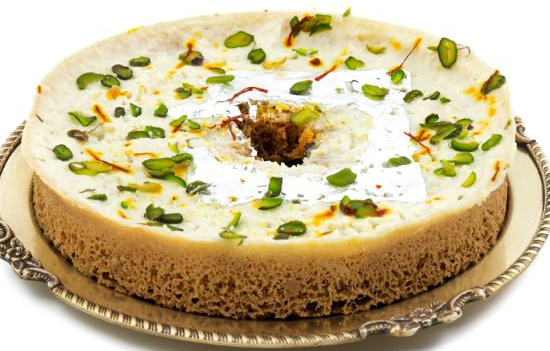 Ghewar.
Ghewar.
One can see piping hot Kadais, in which Ghewar is made, on the
streets of Walled City of Jaipur. The process is quite tedious and a skilled
halwai can make perfect round shape Ghewars that are ideal for the festival of
Teej. There are different kinds of Ghewar available in the market namely traditional
Ghewar, Paneer and Rabri Ghewar. Choose what you like.
On the day of the festival, ladies of the
house dress up in green and enjoy their day on the swings in the garden. On few
occasions, people make a swing out of a rope and decorate it with flowers, in
their homes, to bring in the festivities.
The day is dedicated to Goddess Parvati.
According to tradition Goddess Parvati and Lord Shiva were united after a long
struggle of penance, worship and hardships. So women of the house observe fast
on this particular day and will consume food only after worshipping the moon.
Married woman observe fast for their husband’s long life whereas unmarried girls observe
fast to find a good husband. The beliefs are similar to those of Karwachauth.
In Rajasthan, Teej and Gangaur are more popular festivals. However, Karwachauth
has gained popularity because of daily soaps and Bollywood.
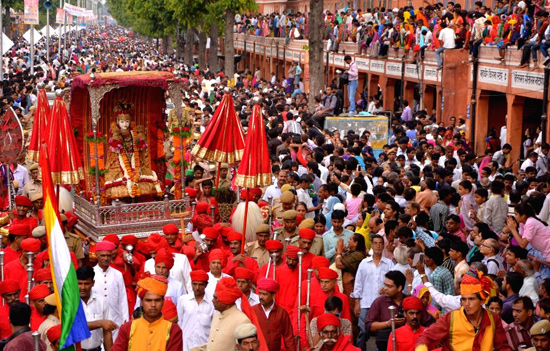 Teej procession in Jaipur.
Teej procession in Jaipur.
During the day, a procession is carried out by women, folk artists singing bhajans (devotional songs) of Goddess Parvati. The Teej procession is a two day affair in Jaipur and is one of the biggest tourist attractions. Every year, tourists gather to witness a vast procession which starts from City Palace Jaipur. The royal procession of Teej Mata consisting of decorated camels, horses, colourful palanquins, bullock carts moves through the Walled City of Jaipur. Local folk artistes sing and dance along the procession which passes through Tripolia Gate, Tripolia Bazaar and Chhoti Chaupar areas of the city.
How
is Kajri Teej celebrated?
Speaking of Kajri Teej (August 25, 2021)
also known as Badi Teej, is celebrated on third day of dark fortnight of
Bhadrapada Hindu month and festivities continues for two days. Apart from
Jaipur, places like Udaipur and Jodhpur focus mainly on Kajri Teej.
Days before the festival, women start
preparing Sattu, a traditional sweet that is consumed on festival day. It is prepared from various flours - Wheat, Rice and Gram Flour. On Badi Teej, women observing fast for entire day break their fast with Sattu, but only after worshipping the moon.
![]()
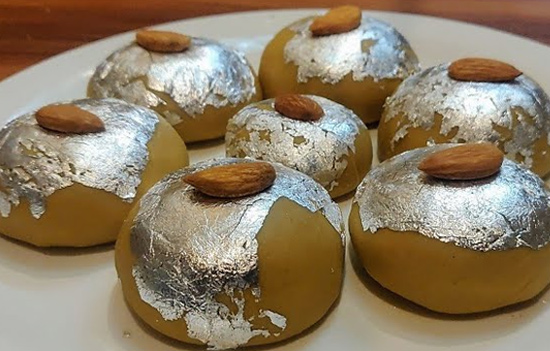 Sattu.
Sattu.
As we move towards the western part of
Rajasthan and head towards the city of Jodhpur - the dialect, food and
traditions take a little bit of a twist. There people celebrate Hariyali Teej
as Chhoti Teej and look forward to Kajri Teej known as Badi Teej.
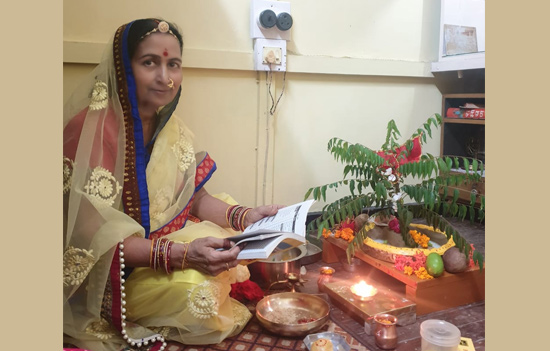 A woman worshipping Neem as part of Teej pooja in Jodhpur.
A woman worshipping Neem as part of Teej pooja in Jodhpur.
A day before the main festival stalls are put up for women to enjoy various delicacies before they observe fast for their marital bliss. On the day of the Teej, they visit Lord Shiva’s temple with their husbands and seek blessing for a happy married life.
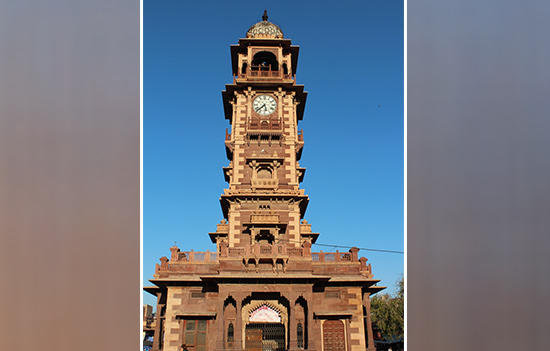 Ghanta Ghar, Jodhpur.
Ghanta Ghar, Jodhpur.
With scanty or no rainfall in the region,
the arrival of Kajri Teej does bring some rains. The old city markets are
flooded with traditional sweets and delicacies. If we go to Ghanta Ghar, a
tourist attraction and also one of the busiest markets in the Blue City, one
would see an amalgamation of various bright colours kicking in the festivities.
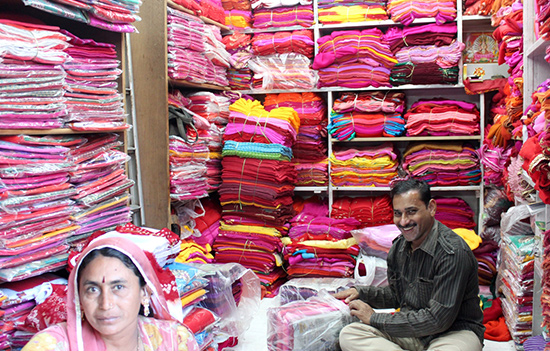 Colourful clothing in shop near Ghanta Ghar.
Colourful clothing in shop near Ghanta Ghar.
Next in the southern part of Rajasthan,
women adorn lehriya sarees and a colourful procession is taken out in Udaipur.
If one walks on the streets of Udaipur during this time of the year, a
tantalising smell of Ghewar and Malpuas will attract you towards sweet shops.
A colourful procession is taken out in the
Lake City. It stops at various Ghats on the banks of Lake Pichola. A special
arrangement is made by the city administration for the seating of tourists who
have come to see the Teej procession.
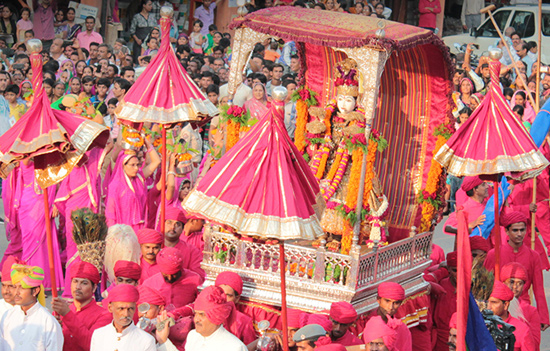 Kajri Teej procession, Udaipur.
Kajri Teej procession, Udaipur.
During the monsoons the Lake City has its
own charm and attracts tourists from all over. It is the best time of the year
to visit when tourists can enjoy both, lovely weather and the traditional Teej
procession.
We covered celebrations in the three
regions. Lastly, in Hadoti region Kajri Teej is celebrated with lots of passion
in Bundi city. Like any other places in Rajasthan, the festivities begin with a
procession of Teej Mata (Hindu Goddess). Women and girls adorn traditional
clothes and enjoy the fair organised on the occasion of Teej. In this fair,
people can purchase various art and handicrafts of Rajasthan and enjoy
delicacies, folk dances and songs of the region.
Teej does have a strong significance in
people’s life all over India. There are different forms and ways of
celebrating it.
Our culture and tradition is what keeps us
connected to our families and thus, these festivals play an important role in
our lives. They give us a refreshing break from our monotonous routine. These
are the days when families get together, taking out time from their hectic
schedules. Apart from a joyful break, they do bring pure happiness in our lives
which is why we look forward to them every year.
Also read
1. Karadaiyaan
Nombu of South has same spirit like Karva Chauth of North
2. About holy
month of Sravana
3. Bundi Fair
4. Holi
ka Dahaan City Palace Udaipur
5. Ghoomar
6. Pushkar Mela